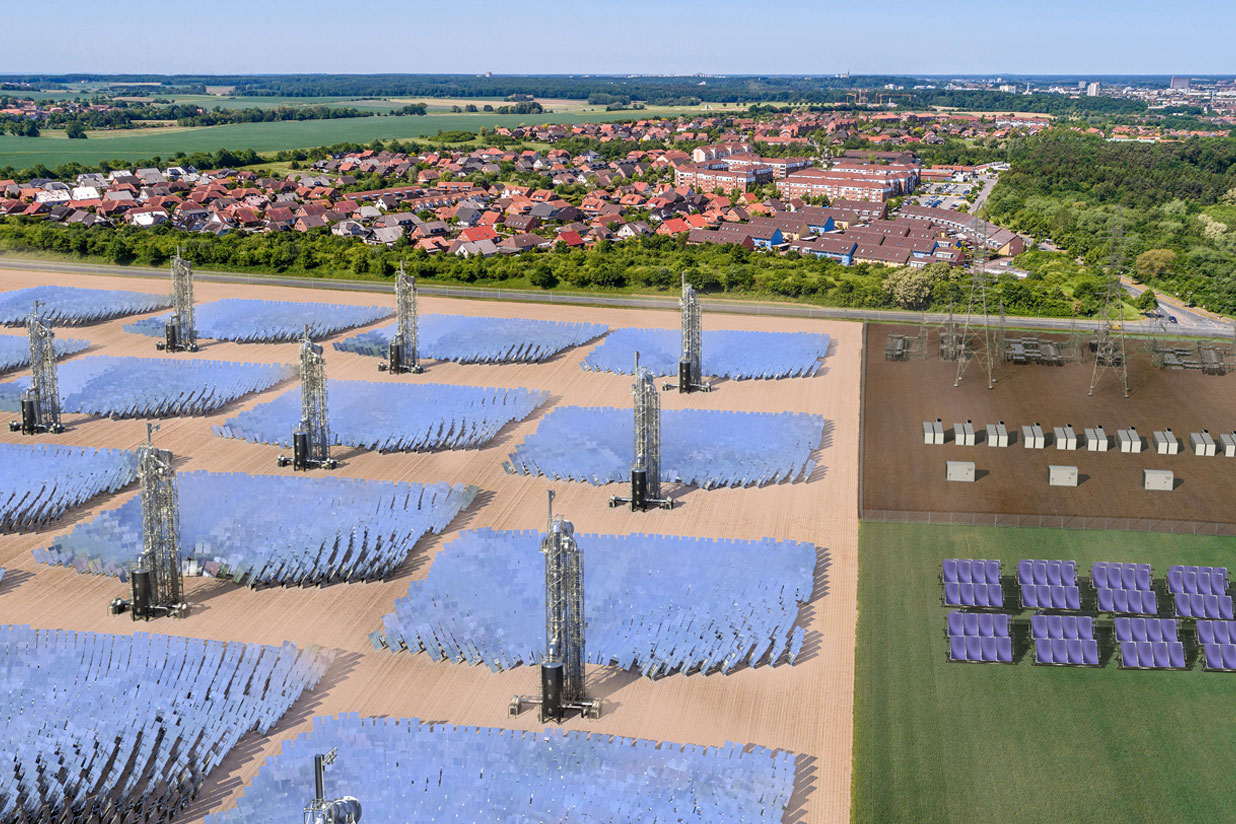Offering clean energy around the clock
Offering clean energy around the clock | MIT News | Massachusetts Institute of Technology MIT News


247Solar: Providing Sustainable Power and Heat with Concentrated Solar Power Systems

Introduction
Renewable energy sources like solar and wind farms have made significant progress in the past two decades. However, achieving complete decarbonization requires the integration of complementary technologies. Renewables offer intermittent power and cannot provide the high temperatures needed for many industrial processes. To address these challenges, 247Solar is developing high-temperature concentrated solar power systems that utilize overnight thermal energy storage to provide round-the-clock power and industrial-grade heat.
The 247Solar System
The modular systems developed by 247Solar can function as standalone microgrids for communities or provide power in remote locations such as mines and farms. They can also be combined with wind and conventional solar farms, enabling customers to have 24/7 power from renewable sources and reduce reliance on the grid.
The system utilizes a field of sun-tracking mirrors called heliostats to reflect sunlight onto a central tower. The tower contains a proprietary solar receiver that heats air to approximately 1,000 degrees Celsius at atmospheric pressure. This hot air drives 247Solar’s turbines, generating 400 kilowatts of electricity and 600 kilowatts of heat. Some of the hot air is stored in a long-duration thermal energy storage system, which heats solid materials to retain the energy. This stored heat can then be used to power the turbines when there is no sunlight.
With this system, 247Solar offers not only round-the-clock electricity but also the option to utilize heat up to 970 degrees Celsius for industrial processes. The company’s approach provides flexibility and versatility to meet various energy needs.
Origins and Development
The inspiration for 247Solar’s system came from the design of a high-temperature heat exchanger developed by the late MIT Professor Emeritus David Gordon Wilson. Anderson, the CEO of 247Solar, worked with Wilson to commercialize the technology in the early 2000s. The company initially received a development grant from the U.S. Department of Energy in 2010 but faced setbacks due to a damaged solar receiver during shipping.
In 2015, Anderson secured funding to revive the company, and advancements in high-temperature metal alloys replaced Wilson’s ceramic heat exchanger. Despite challenges posed by the Covid-19 pandemic, 247Solar has garnered significant customer interest and is currently in talks with communities in the U.S., India, Africa, and Australia for potential deployments.
Advantages and Applications
247Solar’s system offers a cost-effective alternative to diesel generators for off-grid communities, mines, industries, and entire countries seeking 24/7 electricity without relying on fossil fuels. The company’s thermal batteries, which store heat from various sources, provide a more affordable solution compared to lithium-ion batteries. These batteries can store heat for nine hours or more and be used to generate electricity and industrial process heat.
247Solar is actively partnering with financial companies to access capital for its projects and directly sell clean energy to customers. This approach allows for faster growth compared to solely selling entire systems. The company is in advanced discussions with off-grid communities in the U.S. and Egypt, mining operators worldwide, and the government of a small African country.
Conclusion
247Solar’s concentrated solar power systems offer a sustainable solution to meet the increasing demand for clean and reliable energy. By combining renewable power generation with thermal energy storage, the company enables customers to reduce emissions and achieve 24/7 electricity supply. With its flexible and scalable approach, 247Solar aims to contribute to the achievement of the Sustainable Development Goals (SDGs) by providing affordable and environmentally friendly energy solutions.
SDGs, Targets, and Indicators
-
SDG 7: Affordable and Clean Energy
- Target 7.1: By 2030, ensure universal access to affordable, reliable, and modern energy services.
- Indicator 7.1.1: Proportion of the population with access to electricity.
- Indicator 7.1.2: Proportion of the population with primary reliance on clean fuels and technology.
-
SDG 9: Industry, Innovation, and Infrastructure
- Target 9.4: By 2030, upgrade infrastructure and retrofit industries to make them sustainable, with increased resource-use efficiency and greater adoption of clean and environmentally sound technologies and industrial processes.
- Indicator 9.4.1: CO2 emission per unit of value added.
- Indicator 9.4.2: Material footprint, material footprint per capita, and material footprint per GDP.
-
SDG 13: Climate Action
- Target 13.2: Integrate climate change measures into national policies, strategies, and planning.
- Indicator 13.2.1: Number of countries that have integrated mitigation, adaptation, impact reduction, and early warning into primary, secondary, and tertiary curricula.
Table: SDGs, Targets, and Indicators
| SDGs | Targets | Indicators |
|---|---|---|
| SDG 7: Affordable and Clean Energy | Target 7.1: By 2030, ensure universal access to affordable, reliable, and modern energy services. | Indicator 7.1.1: Proportion of the population with access to electricity. |
| SDG 9: Industry, Innovation, and Infrastructure | Target 9.4: By 2030, upgrade infrastructure and retrofit industries to make them sustainable, with increased resource-use efficiency and greater adoption of clean and environmentally sound technologies and industrial processes. | Indicator 9.4.1: CO2 emission per unit of value added. |
| Indicator 9.4.2: Material footprint, material footprint per capita, and material footprint per GDP. | ||
| SDG 13: Climate Action | Target 13.2: Integrate climate change measures into national policies, strategies, and planning. | Indicator 13.2.1: Number of countries that have integrated mitigation, adaptation, impact reduction, and early warning into primary, secondary, and tertiary curricula. |
Analysis
1. Which SDGs are addressed or connected to the issues highlighted in the article?
The issues highlighted in the article are connected to the following SDGs:
– SDG 7: Affordable and Clean Energy
– SDG 9: Industry, Innovation, and Infrastructure
– SDG 13: Climate Action
2. What specific targets under those SDGs can be identified based on the article’s content?
Based on the article’s content, the specific targets under the identified SDGs are:
– Target 7.1: By 2030, ensure universal access to affordable, reliable, and modern energy services.
– Target 9.4: By 2030, upgrade infrastructure and retrofit industries to make them sustainable, with increased resource-use efficiency and greater adoption of clean and environmentally sound technologies and industrial processes.
– Target 13.2: Integrate climate change measures into national policies, strategies, and planning.
3. Are there any indicators mentioned or implied in the article that can be used to measure progress towards the identified targets?
The article mentions or implies the following indicators that can be used to measure progress towards the identified targets:
– Indicator 7.1.1: Proportion of the population with access to electricity.
– Indicator 9.4.1: CO2 emission per unit of value added.
– Indicator 9.4.2: Material footprint, material footprint per capita, and material footprint per GDP.
– Indicator 13.2.1: Number of countries that have integrated mitigation, adaptation, impact reduction, and early warning into primary, secondary, and tertiary curricula.
These indicators can provide quantitative data to assess the achievement of the targets related to affordable and clean energy, sustainable infrastructure and industries, and climate action.
By addressing these targets and monitoring the corresponding indicators, progress can be measured towards achieving universal access to affordable and clean energy, upgrading infrastructure for sustainability, and integrating climate change measures into policies and planning.
Overall, the article highlights the importance of developing complementary technologies, such as high-temperature concentrated solar power systems, to achieve complete decarbonization and provide round-the-clock power and industrial-grade heat. This aligns with the SDGs’ focus on affordable and clean energy, sustainable infrastructure and industries, and climate action.
Copyright: Dive into this article, curated with care by SDG Investors Inc. Our advanced AI technology searches through vast amounts of data to spotlight how we are all moving forward with the Sustainable Development Goals. While we own the rights to this content, we invite you to share it to help spread knowledge and spark action on the SDGs.
Fuente: news.mit.edu

Join us, as fellow seekers of change, on a transformative journey at https://sdgtalks.ai/welcome, where you can become a member and actively contribute to shaping a brighter future.







